We were in the woods yesterday, despite the rain. We cycled up on the electric bikes, as we like to avoid driving up and down the track, if possible, when it's muddy. Of course, there are times that we have to drive up and, and the same applies to other owners in the wood, but every time we go on bike that's one less trip and a bit less damage.
While I was waiting for a friend to arrive I had a look at a stream in one of the other patches in the woods, that a friend of mine has just finished purchasing. With the rain in the past couple of days it was in full flow:
and further upstream it had spread to leave a wider wet area: I'm somewhat envious - it would be nice to have a stream this big in our wood too!
I'm somewhat envious - it would be nice to have a stream this big in our wood too!
On the wayleave it's easy to see the animal tracks now that the leaves have died back and the ground is wet. Here's one that's used by deer and boar: When Ian arrived we had a walk around the wood, talking about the different things we're doing. He's just getting into forestry work, so we had a lot to chat about. We felled a few trees, giving Ian a chance to see some new techniques - though I took pains to remind him that I'm not a qualified instructor and he still needs to go on a training course! Here we are looking at how to remove a small tree that I'd deliberately hung up:
When Ian arrived we had a walk around the wood, talking about the different things we're doing. He's just getting into forestry work, so we had a lot to chat about. We felled a few trees, giving Ian a chance to see some new techniques - though I took pains to remind him that I'm not a qualified instructor and he still needs to go on a training course! Here we are looking at how to remove a small tree that I'd deliberately hung up: By the way, I wrote a post yesterday on dealing with hung up trees.
By the way, I wrote a post yesterday on dealing with hung up trees.
Before we went home Tracy built a small fire to dry one of her shoes, which had managed to collect rain despite being under the shelter! Her shoe ended up smelling of smoke, but it probably made the bike ride home a little more comfortable.
Her shoe ended up smelling of smoke, but it probably made the bike ride home a little more comfortable.
We're up there again tomorrow, partly to work, but also because we have a class of five-year-olds visiting from a local school!
Mike
Sunday, 30 November 2008
Wet day in the woods
Friday, 28 November 2008
Dealing with a hung up tree and a broken branch
One of the most popular posts on our blog has been "What NOT to do with a hung up tree"
So, when I got a tree hung up on Thursday I thought I'd take some pictures of getting it down. Of course, it's better not to get it hung up in the first place, but sometimes it's unavoidable, and we all make mistakes from time to time as well.
Here's the hung up tree: The first thing to do is to use the cant hook on a felling lever to roll the tree. In some cases this can bring the tree down straight away, although in this case it didn't. It did get it off the stump though, which I also wanted to do. Remember to always roll the tree away from you, and bend your legs to lift the lever - reposition the lever as required during the rolling.
The first thing to do is to use the cant hook on a felling lever to roll the tree. In some cases this can bring the tree down straight away, although in this case it didn't. It did get it off the stump though, which I also wanted to do. Remember to always roll the tree away from you, and bend your legs to lift the lever - reposition the lever as required during the rolling.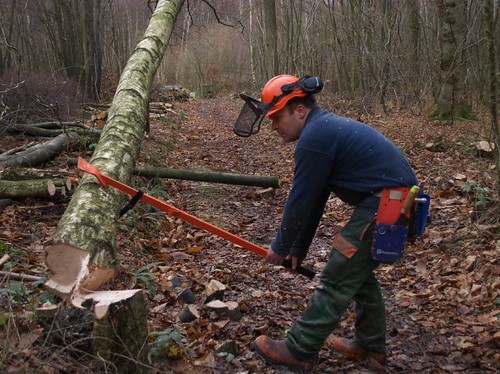
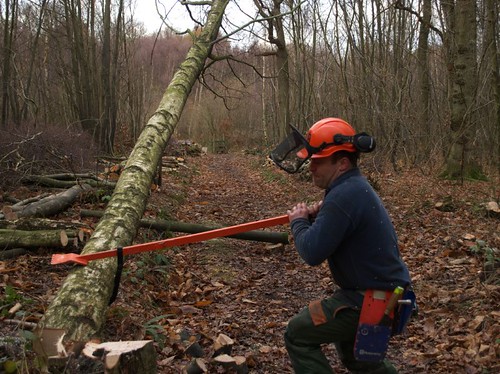 Once the tree is on the ground, the next thing to do is move the butt backwards. In this case the long felling lever gave enough leverage. You put it under the butt, then lift and turn to move it backwards:
Once the tree is on the ground, the next thing to do is move the butt backwards. In this case the long felling lever gave enough leverage. You put it under the butt, then lift and turn to move it backwards:
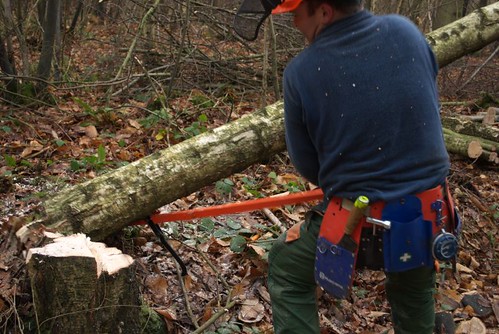 In an older post I used a long pole to give more leverage, and also a winch when that wasn't sufficient.
In an older post I used a long pole to give more leverage, and also a winch when that wasn't sufficient.
After a couple of minutes pushing the butt back the tree was safely on the ground: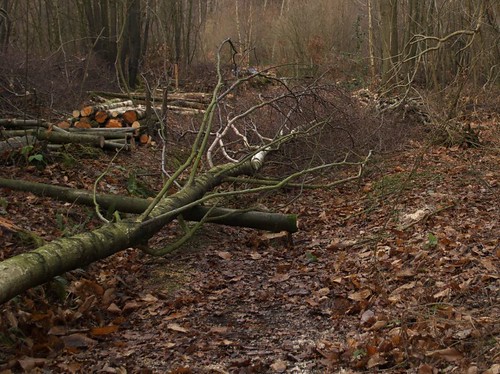 and then easily snedded and logged:
and then easily snedded and logged: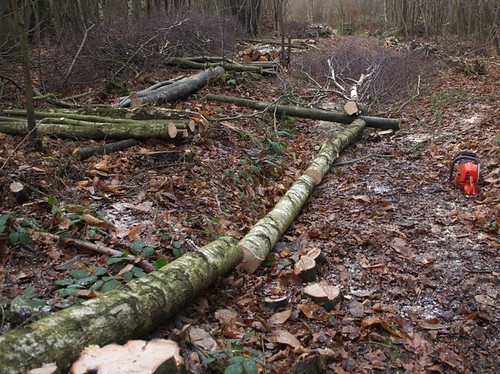 We were left with one other problem though - a branch in an oak tree that had been broken when the birch came down. As it was alongside a path I didn't want to leave it. It was too tall to reach with our pole saw, so I attached a rope to it:
We were left with one other problem though - a branch in an oak tree that had been broken when the birch came down. As it was alongside a path I didn't want to leave it. It was too tall to reach with our pole saw, so I attached a rope to it:

 Then I retreated to a safe distance with the rope, and gave it a few tugs:
Then I retreated to a safe distance with the rope, and gave it a few tugs: bringing the branch down easily, to be left for bugs to live in:
bringing the branch down easily, to be left for bugs to live in: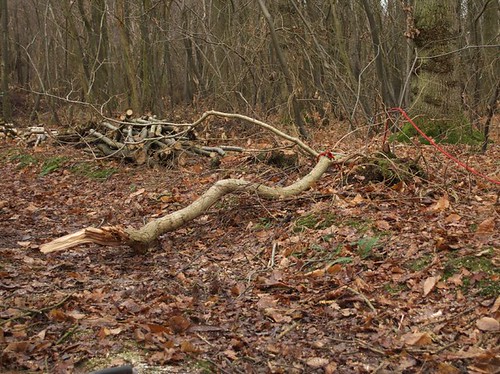 One final thing - we try to avoid killing honeysuckle while felling, as it is a vital food plant for the White Admiral butterfly. However, sometimes I wish we got rid of it all...
One final thing - we try to avoid killing honeysuckle while felling, as it is a vital food plant for the White Admiral butterfly. However, sometimes I wish we got rid of it all...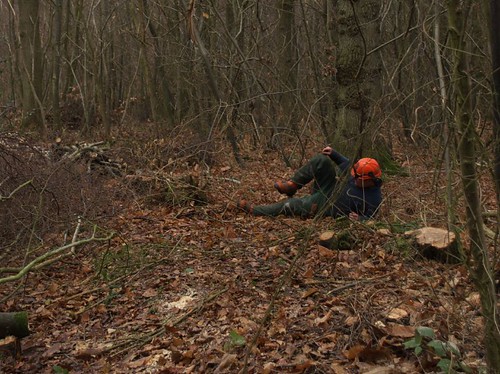 This is why you have to clear an area around the base of a tree you're going to fell, and also your escape route!
This is why you have to clear an area around the base of a tree you're going to fell, and also your escape route!
Mike
Monday, 24 November 2008
Odds and ends
It was raining today :-(
Tracy had some stuff to get done in Rye, so I went up to the wood on my own. I'm not entirely comfortable working alone felling trees alongside the public footpath, as it's good to have a second person as a lookout for walkers, so I did some odd jobs that had been waiting. Like sharpening one of the saw chains that had got blunt last Friday. We rotate a group of three chains on each saw, so when one gets blunt you can just swap to another, as long as you remember to come back and sharpen it when you have time! It also has the advantage of wearing out all the chains at the same time that the drive sprocket needs changing, then you can start again with a new set and sprocket.
Anyway, the other thing that needing doing was gathering together the bits of birch that were left in various places around the area we cut last winter and converting them to firewood. Not especially exciting, but quite satisfying work to do. I've stacked the logs under the drying shelter for now to keep the rain off them.
I've stacked the logs under the drying shelter for now to keep the rain off them. Fortunately the sun came out later, and I got some pictures of what's going on in the wood.
Fortunately the sun came out later, and I got some pictures of what's going on in the wood. It's looking kind of desolate now the leaves have gone.
It's looking kind of desolate now the leaves have gone.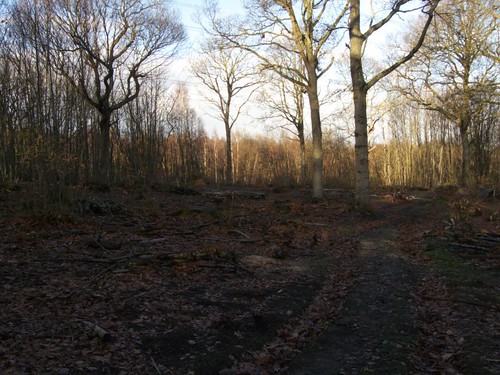 and the oaks are looking positively skeletal:
and the oaks are looking positively skeletal: I noticed something interesting out on the wayleave. On a small oak tree were some "oak apples", which are formed by gall wasps. Earlier in the year these were shades of green, but now they've turned brown and you can see a hole where the wasp dug its way out:
I noticed something interesting out on the wayleave. On a small oak tree were some "oak apples", which are formed by gall wasps. Earlier in the year these were shades of green, but now they've turned brown and you can see a hole where the wasp dug its way out: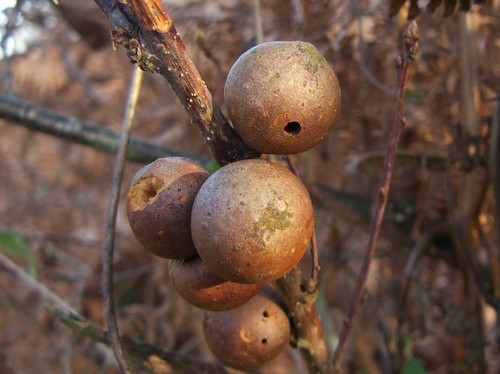 I cut one open, revealing the hollow centre where the insect developed:
I cut one open, revealing the hollow centre where the insect developed: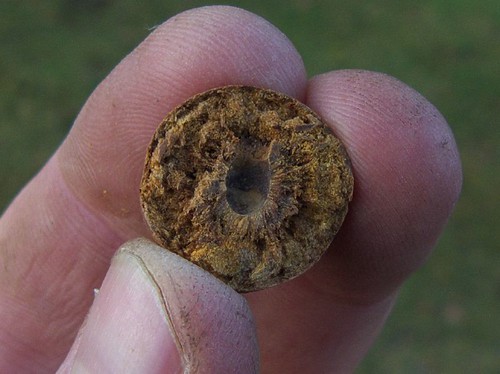 That's all for now, we're back in the wood on Thursday...
That's all for now, we're back in the wood on Thursday...
Mike
Friday, 21 November 2008
Back to the coppicing...
My busy period at work has drawn to a close for now, so we were up at the wood today. Also, I'm only working two days a week for the next four weeks, so we'll have lots more opportunities to get up there.
We got straight back into coppicing along the footpath, and with the clearing of small stuff completed a few weeks ago we made good progress. Here's a before and after shot of the area I was working:
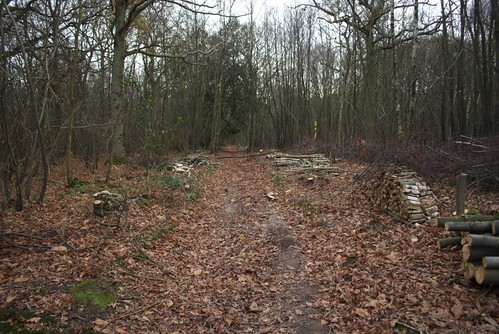 and here's Tracy's area:
and here's Tracy's area:
 I realise those photos don't really do it justice, so here's some from the stile and the furthest point we've cut to on that stretch:
I realise those photos don't really do it justice, so here's some from the stile and the furthest point we've cut to on that stretch: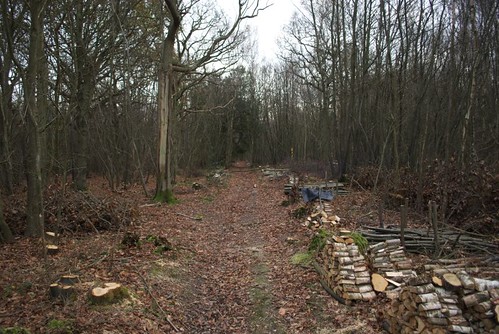
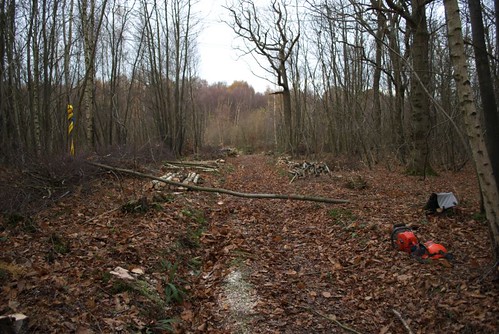 As you can see, there's quite a corridor building up now. I can't wait to see how it will look next summer when everything starts growing. I have visions of it being filled with birds and butterflies, but we'll wait and see if the sunlight entices them in...
As you can see, there's quite a corridor building up now. I can't wait to see how it will look next summer when everything starts growing. I have visions of it being filled with birds and butterflies, but we'll wait and see if the sunlight entices them in...
One important point to mention is dormice. After a visit from a local dormouse officer (yes, they really exist - these creatures are protected by law!), we've taken their advice and left "pinch points" across the path, where trees touch over the top of it. You can see two of them in the above pictures, one is the holly tree, the other is the oak that's been struck by lightning. If these points aren't left, then the dormice can get stuck in one part of the wood, as they generally only travel in the trees, not along the ground. We've never actually seen a dormouse in the wood, but we've been told to assume they are there, because they probably are.
We been able to put some of what we learned on the coppice harvesting course into practice today, using our shiny new 3-tonne (overkill perhaps? Or just planning ahead...) slings to hold up benches: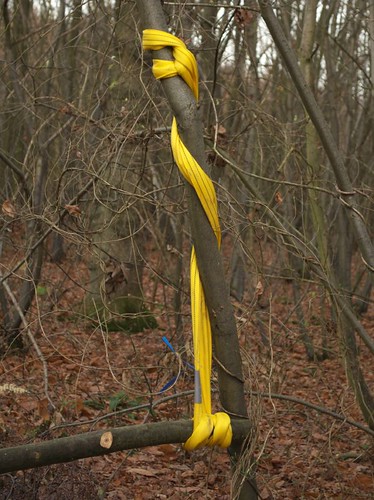
 although sometimes the banks of the path plus a coppice stool or log pile get the bench high enough on their own, as below, where I've just snedded a tree felled onto the bench.
although sometimes the banks of the path plus a coppice stool or log pile get the bench high enough on their own, as below, where I've just snedded a tree felled onto the bench.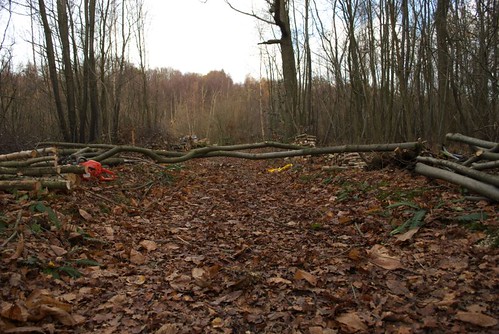 The whole point of this is to keep the tree at a comfortable height for working without having to bend over, and also avoids the risk of the chainsaw touching the ground, which can blunt it pretty quickly.
The whole point of this is to keep the tree at a comfortable height for working without having to bend over, and also avoids the risk of the chainsaw touching the ground, which can blunt it pretty quickly.
Anyway, that's all for now. We're at a wedding tomorrow, so won't be up at the wood. Sunday looks like the weather may be "interesting", in which case we might go to the wood to take some pictures, but probably not to work. Monday we'll be back to coppicing again :-)
Mike
Sunday, 16 November 2008
A walk around a different wood
This afternoon we went to visit our friends Rod and Heather in their wood, about 10 miles from us. We went on the electric bikes, being cheaper than going by car and also enjoyable, riding through the countryside.
It's always interesting visiting other woods, as you often get ideas and learn about things you never see in your own wood. Every wood is different, in terms of fauna & flora, geography, hydrography, history and especially what the owner plans to do with it. There are many ways to manage a wood. Some people focus on producing timber, some on firewood and logs, some on biodiversity and others on keeping game. All are valid, and not necessarily mutually exclusive.
Rod and Heather's wood looks somewhat like ours at certain points: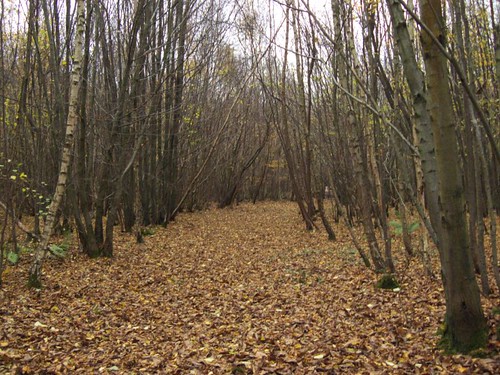 But at other points they are completely different!
But at other points they are completely different!

 The pond in the picture above is actually formed by a pit left by ancient mining operations, according to the archaeologist they've had to visit them.
The pond in the picture above is actually formed by a pit left by ancient mining operations, according to the archaeologist they've had to visit them.
I was particularly interested to see what had happened to some piles of logs that had been left there for years: The piles looked like they should have been collected, being stacked at ride-side, but had been forgotten and now have become wildlife sanctuaries. We've left some similar piles in our own wood, some deliberately, and some because we never got round to using them, and probably won't, so it was nice to see how they might look in years to come.
The piles looked like they should have been collected, being stacked at ride-side, but had been forgotten and now have become wildlife sanctuaries. We've left some similar piles in our own wood, some deliberately, and some because we never got round to using them, and probably won't, so it was nice to see how they might look in years to come.
We also saw why squirrel control can be a good thing. Rod and Heather have been plagued by squirrels, with the result that the few dozen young oak trees they had are now severely damaged: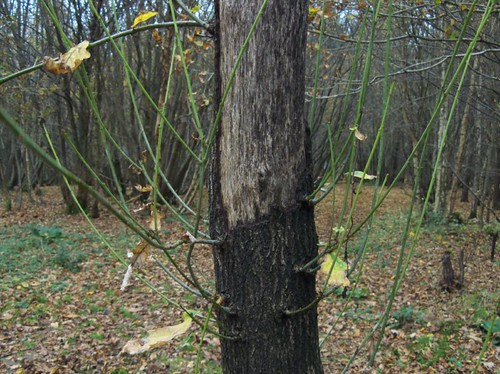
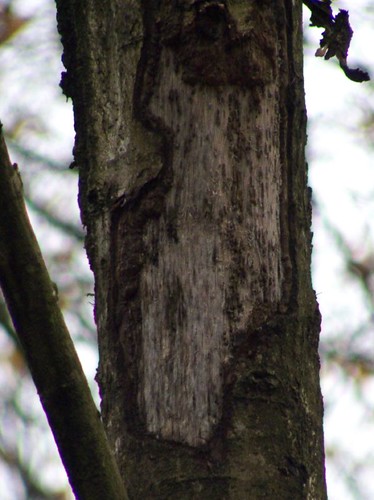 Some of the oaks that have been attacked will survive in a stunted form, others won't make it. The squirrels had attacked many other trees too, going back several years by the look of it.
Some of the oaks that have been attacked will survive in a stunted form, others won't make it. The squirrels had attacked many other trees too, going back several years by the look of it.
Some of them had become good dead wood habitats, with a range of fungi growing on them:
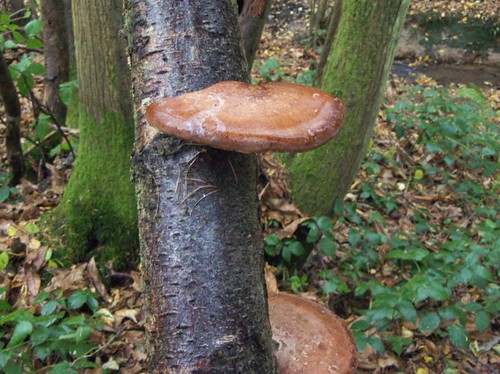
 However, I'm not sure if this makes up for the fact that a whole generation of oaks across several acres have been damaged...
However, I'm not sure if this makes up for the fact that a whole generation of oaks across several acres have been damaged...
We saw an interesting feature in one dead tree though - holes made by a woodpecker: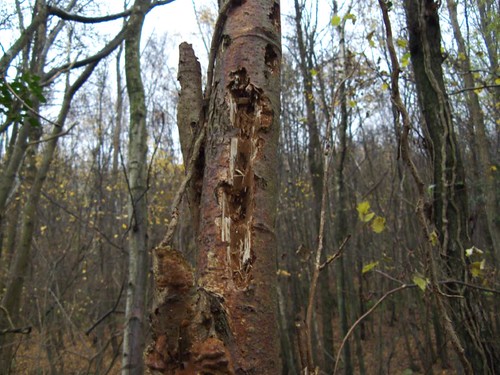
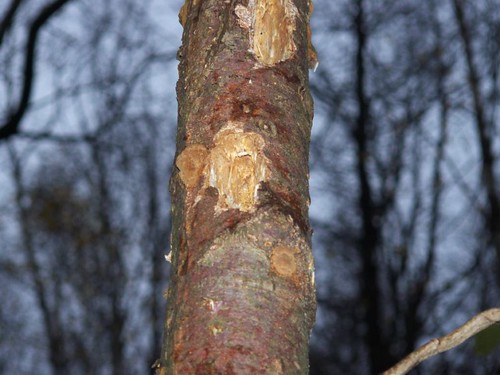 To finish, here's a great little stove that Rod had made:
To finish, here's a great little stove that Rod had made: The base is a cylinder liner from a ferry engine, the top used to have a damper valve in it, and various bits have been welded on to make a chimney.
The base is a cylinder liner from a ferry engine, the top used to have a damper valve in it, and various bits have been welded on to make a chimney.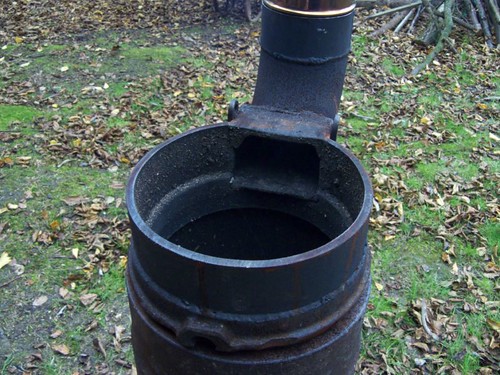 You fuel it through the top and then put the hot plate on.
You fuel it through the top and then put the hot plate on.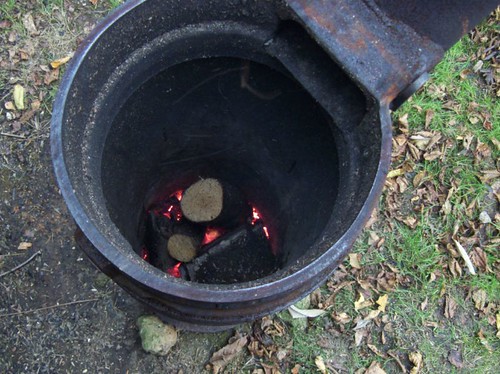 Air comes in at the bottom, made possible by resting the stove on a few small stones.
Air comes in at the bottom, made possible by resting the stove on a few small stones. 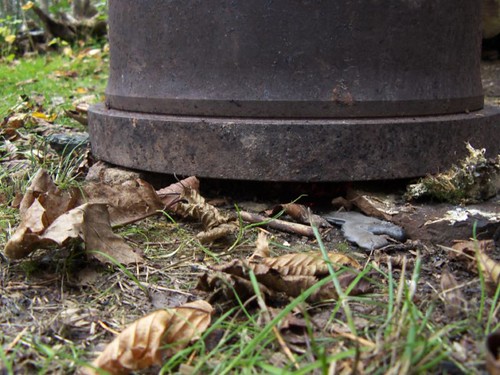 That's all for this weekend. I'm really looking forward to Friday - a chance to get back into our own wood and make some serious progress widening the rides to make the wildlife corridors.
That's all for this weekend. I'm really looking forward to Friday - a chance to get back into our own wood and make some serious progress widening the rides to make the wildlife corridors.
Mike
Saturday, 15 November 2008
Visiting other woods
We went on a brief visit to some nearby woods today, with Tracy in her role as SWOG co-ordinator, as Steve from Butterfly Conservation was doing a visit. First though we had a load of firewood to deliver locally: As I'd hoped, the track in the wayleave had dried out during the week, so the only bit we had to push the trailer over by hand was the last bit in and out of the wood itself. The firewood drying shelter's looking a bit bare now:
As I'd hoped, the track in the wayleave had dried out during the week, so the only bit we had to push the trailer over by hand was the last bit in and out of the wood itself. The firewood drying shelter's looking a bit bare now: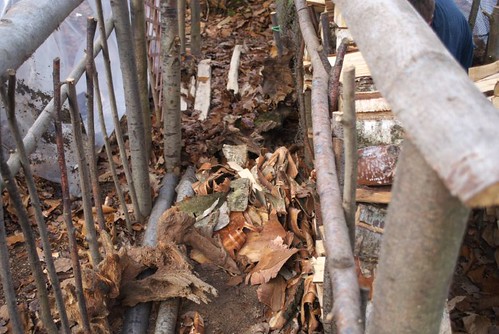 The wood we went to visit is very different from ours, as it is a PAWS (Plantation on Ancient Woodland Site). Much darker, because of the coniferous trees, and much hillier as well!
The wood we went to visit is very different from ours, as it is a PAWS (Plantation on Ancient Woodland Site). Much darker, because of the coniferous trees, and much hillier as well!
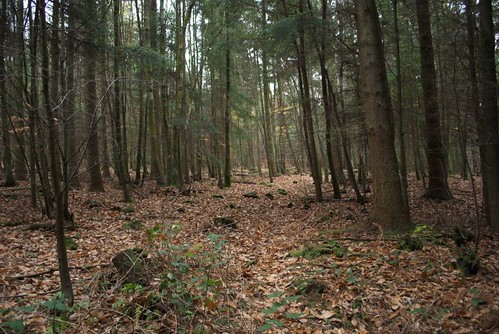
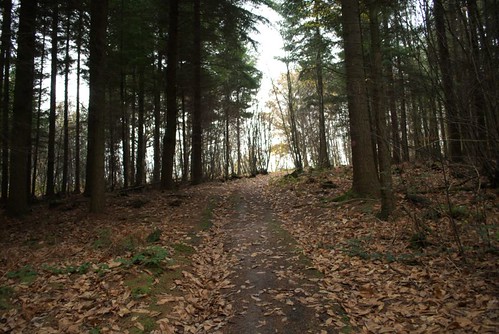 It had different fungi as well, which isn't surprising:
It had different fungi as well, which isn't surprising: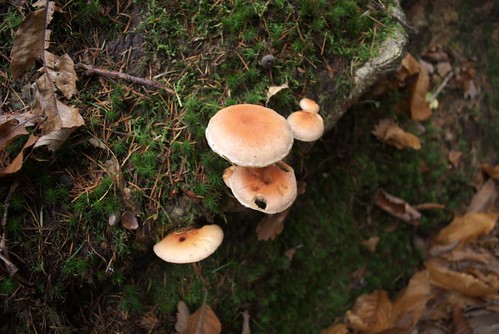 There were some parts that looked familiar, like this section of 3-year old chestnut coppice regrowth, although in this case the coppice had been overstood and neglected - the coppice in our own wood was last cut about 15 years ago, so is decades away from being described as "neglected", especially as we're working it again now!
There were some parts that looked familiar, like this section of 3-year old chestnut coppice regrowth, although in this case the coppice had been overstood and neglected - the coppice in our own wood was last cut about 15 years ago, so is decades away from being described as "neglected", especially as we're working it again now!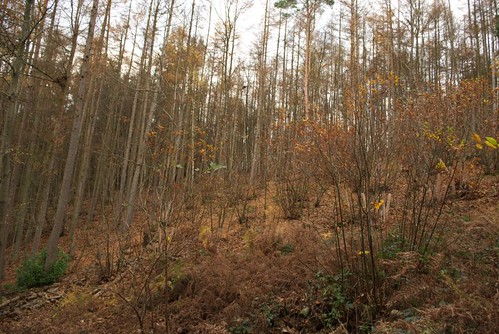 Steve emphasised that lighter sections like this were just what butterflies needed, and also that butterflies are a good indicator species - if they're there, so are other invertebrates and the creatures that feed on them. If the butterflies aren't there, then there's not much else around either.
Steve emphasised that lighter sections like this were just what butterflies needed, and also that butterflies are a good indicator species - if they're there, so are other invertebrates and the creatures that feed on them. If the butterflies aren't there, then there's not much else around either.
The other important thing was connectivity - having well-lit corridors through the wood connecting the different open areas - as the butterflies won't fly through a dark section of woodland. This applies to birds too, but to a lesser extent. Creating corridors is what we're doing this winter with our coppicing along the rides - which we'll be able to restart at the end of this week, when I switch to only working 2 days a week for the Ashden Awards until January.
Mike
